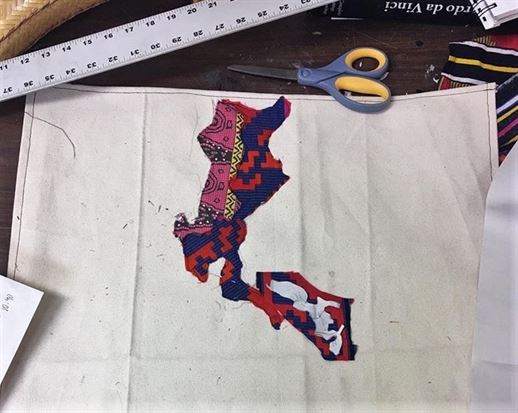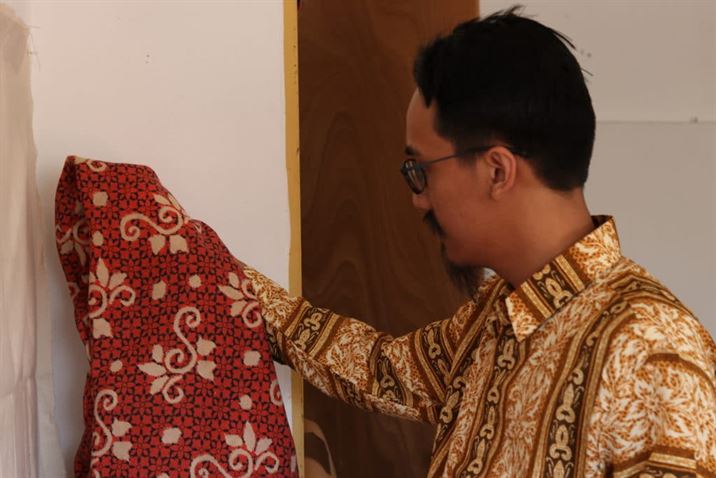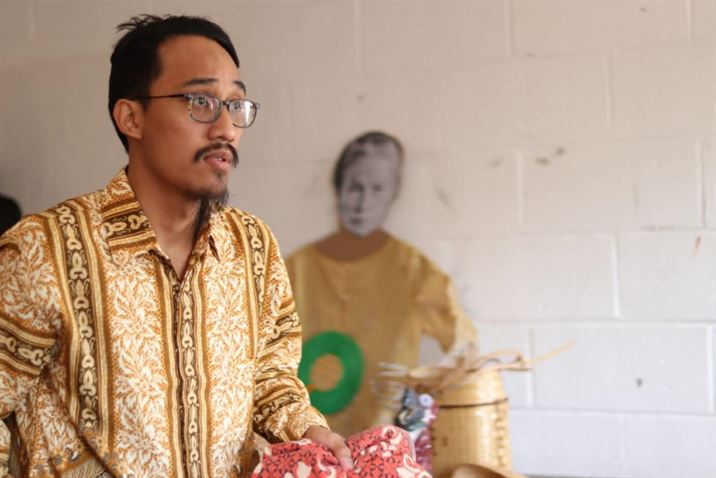Paolo Punay is a senior at Montclair State University and is a BFA studio major with a concentration in painting. Through his exploration of his own culture, Punay grasps for what it means to be Filipino and uses fashion as a social statement. He spoke with The Montclarion contributing writer Soraya Mitta about his exploration of his own country’s heritage.
Q: Can you tell me a little bit about your thesis project entitled, ‘Balikbayan?’
A: It has to do with the effects of colonization on native Filipino populations because I feel like that history still has to be tapped into. There is a lot of potential in that subject matter because a lot of countries around the world have similar problems, so it’s something of a universal idea that can be mined for potential projects. That’s the reason why I chose it, I guess. That and it’s something that I want to learn more about because I don’t know too much about my own country.
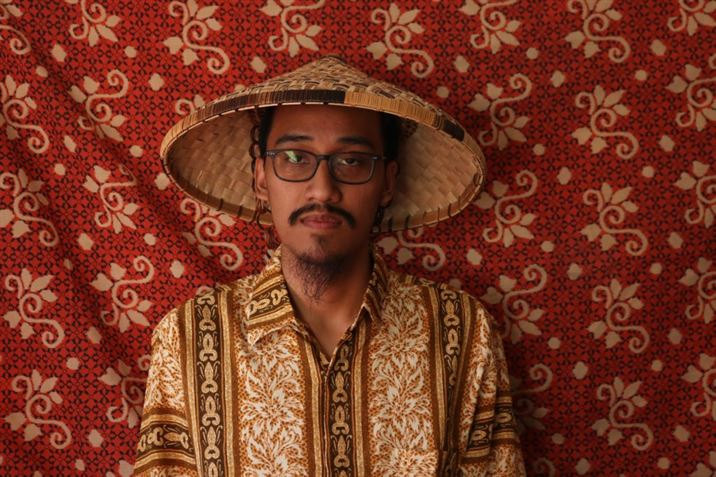
Paolo Punay poses in his traditional Filipino inspired clothing he designed.
Mackenzie Robertson | The Montclarion
Q: What is your personal connection to the Philippines?
A: I was born there and I lived there until I was 7 years old, because that’s when my mom immigrated to this country to become a nurse. She was already a nurse but she wanted to get a better job for her family. This thesis is a way for me to learn more about my history that I missed because once I left, I didn’t know anything about Filipino history, so this is like a chance for me to revisit that.
Q: What is the symbolism behind the objects in your work and their placement?
A: I’m still trying to figure that out, to be honest. That’s why it’s still a work in progress, but I want to try to use regular-looking objects and have some kind of narrative about them that relates to the history of the Philippines. I have this idea of having this straw hat that rice planters wear, and have bags of rice hanging from it and then it’s like you could wear it and it has something to do with how the first president ‘of the Philippines’ sold out the Philippines for 400,000 pesos. I wanted to replace the pesos with rice because you can feel the weight of that when you wear the object, so I want to try to use regular objects and re-imagine them into art pieces.
Q: What are your thoughts on cultural appropriation?
A: I have this idea of appropriation because I find appropriation a funny subject. Where it’s like, only one culture can do this kind of thing, only you can do this kind of thing because you are that culture, so I want to play with this idea of, ‘Well, it’s human culture, so why can’t we share it all for us?’ If it’s coming from the same root. That’s, I guess, a reason. That’s why I like to juxtapose things, because it shows you that we are all the same. We all have commonalities, but it is the differences that make us who we are. And I wanted to emphasize that.
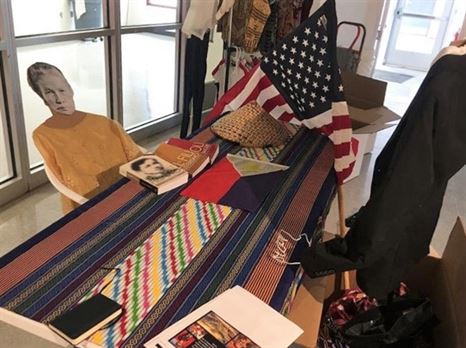
Some of the elements used to create Punay’s work, Balikbayan, are situated together.
Photo courtesy of Paolo Punay
Q: When did you know you wanted to be an artist?
A: I had an inkling when I was about maybe eight or nine when I drew an anime head and I was like, ‘Oh that looks good.’ But what really fed me was in high school. That’s what I was really into in high school, and then it was the praise people gave you. So I kept dialing it in and I was like, it’s the only thing I’m good at so, I got to do something with it.
Q: What brought you to the Montclair State Art Department?
A: What brought me here was my teacher. My English teacher senior year of high school recommended this place because his sister went here, and he said it has a good program. So, I was like, ‘Alright, sounds like a good place to go, so I’ll go.’ And it’s not William Paterson, so I went here.
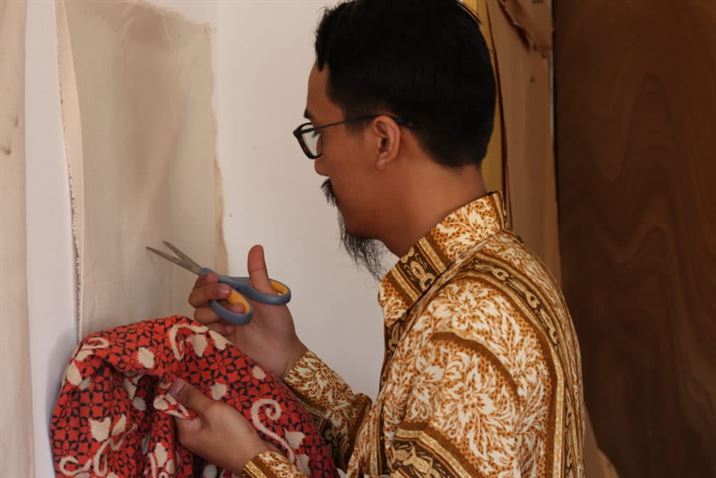
Punay points to his blank map, explaining how he plans to place his fabric.
Mackenzie Robertson | The Montclarion
Q: Can you define what ‘Balikbayan’ means?
A: ‘Balikbayan’ literally translates to ‘back to your country,’ so the concept, or the idea of balikbayan box, is taking stuff from the United States or any foreign country that the Filipino diaspora spread them out to, and send everything that they have, like clothes, food, toys and stuff, sending it back to the Philippines, so that everybody benefits from it.
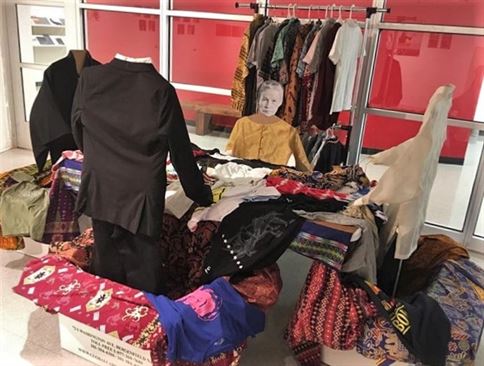
The fabric and mannequins that make up Punay’s Balikbayan display are grouped together.
Photo courtesy of Paolo Punay
Q: Why did you choose to name your work that?
A: I chose to use ‘Balikbayan’ because that’s what I want to do with this work, is try to go back to my country and see what I can learn from it, what I can show people, that makes the Philippines unique. I guess that’s a reason why I chose that title because I have been going back and forth about the title, but I guess it works for what I want it to be.
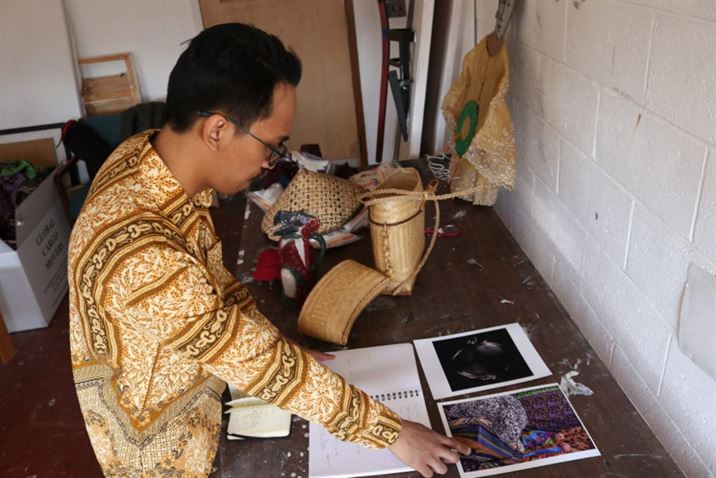
Punay goes through his project notebooks and explains the plans for his project.
Mackenzie Robertson | The Montclarion
Q: What are your plans for the future?
A: Try to find a job? Not starve? I have no idea to be honest. The dream is, or the goal at least, is to become a painting professor or something to do with curating or, what’s it called, conservation? I love working on stuff that’s already been made, if that makes sense. That’s an aspect of conservation I love, which is like, it’s already there. It’s already almost perfect, you just have to make it perfect. That’s the reason why I like conservation, which doesn’t make sense why I’m a painting major. But you know what? Two more semesters.
Q: What do you want people to take away from your work when they look at it?
A: I want them to take away some history of who the Filipinos are, what they are about and a deeper understanding of global politics in a way. Because it’s like, this may just be one country, but this topic applies to loads of other countries that have suffered from colonization and imperialization, so I want them to learn that this situation isn’t entirely unique to one place and it’s something that can be applied everywhere.
Q: Dealing with all the issues with immigration in America right now, is your art work making a statement toward those kinds of issues?
A: I don’t think so. I’m more focused on education rather than trying to say a specific message, in a way, because I don’t want to berate people with like, ‘This is my political philosophy, blah, blah, blah.’ It’s more of like, ‘This is what I learned from this and I hope you guys learned from it, too.’ So, I guess it’s the educator in me.

